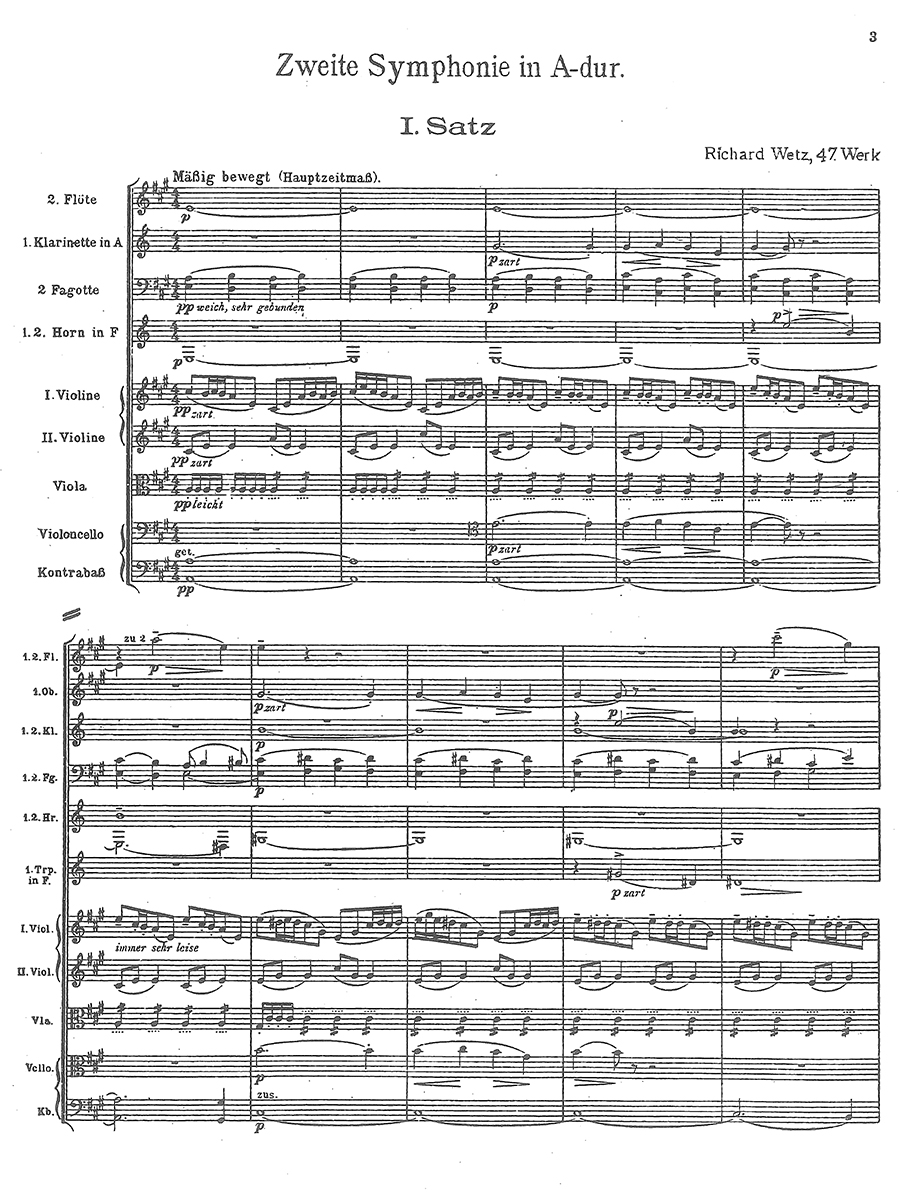Symphony No. 2 in A major, op. 47
Wetz, Richard
33,00 €
Preface
Richard Wetz
Symphony No. 2 in A major, op. 47
(1919)
(b. Gleiwitz
I Hauptzeitmaß. Mäßig bewegt (p. 3) – Sehr ruhig und mit Innigkeit (p. 14) – Breit, mit aller Kraft –
Energisch bewegt (p. 19) – Ruhig (p. 20) – Noch ruhiger (p. 21) – Erstes Hauptzeitmaß (p. 22) –
Im ruhigen Hauptzeitmaß (p. 23) – Wieder bewegter (p. 27) – Majestätisch (p. 30) – Etwas fließender (p. 34) –
Etwas gehaltener (p. 37) – Im ersten Hauptzeitmaß (p. 38) – Sehr ruhig und mit Innigkeit (p. 46) –
Etwas zurückhalten (p. 47) – Im Hauptzeitmaß, aber etwas bewegter (p. 51) – Im ersten Hauptzeitmaß (p. 55) –
Etwas breiter (p. 57) – Im Hauptzeitmaß, etwas gehalten (p. 60)
II Langsam, mit klagendem Ausdruck (p. 63) – Sehr ruhig und ausdrucksvoll (p. 69) – Etwas drängend (p. 71) –
Im Zeitmaß (p. 72) – Drängend (p. 74) – A tempo (p. 75) – Wie zu Anfang (p. 76)
III Finale. Bewegt, ruhige Halbe (p. 84) – Langsam und ausdrucksvoll (p. 95) – Erstes Zeitmaß (p. 98) –
Etwas gehalten (p. 101) – Im Zeitmaß (p. 103) – Allmählich vorwärts drängend (p. 107) – Zurückhalten –
Breit (p. 110) – Ruhig und ausdrucksvoll – Mit größter Kraft und Wucht (p. 111) – Erstes Zeitmaß (p. 113) –
Ruhiger (p. 119) – Getragen und ausdrucksvoll (p. 121) – Etwas drängend (p. 124) – Wuchtig und schwer, breit (p. 125) – Im Hauptzeitmaß, etwas gehalten (p. 127) – Im Hauptzeitmaß, erregt (p. 128) – Im Hauptzeitmaß (p. 130) –
Etwas breiteres Hauptzeitmaß (p. 133)
Preface (by Christoph Schlüren, Mai 2016)
As Johannes Brahms put it in a different context, “any donkey can hear” that Richard Wetz’s symphonies were influenced by Anton Bruckner. It is a fact that also applies, in a quite different form, to a Nuremberg symphonist three decades his junior, Martin Scherber (1907-1974), who, like Wetz, composed three monumental symphonies that are likewise unthinkable without Bruckner’s musical language. And yet, for all the obviousness of its undeniably Brucknerian moments and phrases (especially in the obsessive way it builds its climaxes), Wetz’s formal psychology is completely different in kind, one of romantic discontent. And if he wrote large-scale sacred works in later life, such as the Requiem and Christmas Oratorio, it becomes clear how little he actually had in common with Bruckner in expression and aspiration. It is, of course, regrettable that Wetz never managed to write his projected fourth symphony; but given his line of evolution, we may safely assume that it would have been even more remote from Bruckner than its three predecessors.
Richard Wetz was the son of an Austrian merchant named Georg Wetz (1849-1903) and Klara Wetz née Mucha (1852-1906). Although he revealed a talent for music in early childhood, he was eight years old before he received his first piano lessons, and he began to write lieder and piano pieces. Upon hearing Mozart’s great G-minor Symphony (K. 550) at the age of thirteen, he firmly resolved to become a composer. In 1897, after taking his school leaving certificate, he enrolled at Leipzig Conservatory, where he was taught by the venerable masters Carl Reinecke (1824-1910) and Salomon Jadassohn (1831-1902). Disappointed by the conservatory’s hopelessly conservative spirit and its rejection of every innovation from the “New German School” of Franz Liszt and Richard Wagner, he left after a mere six weeks and took private lessons from Richard Hofmann (1844-1918), the former head of the Leipzig Singakademie, and from Alfred Apel, a student of Friedrich Kiel. He also took courses in philosophy, psychology, and literature at Leipzig University, developing a special predilection for the ideas of Arthur Schopenhauer and devoting himself to a study of the writings of Goethe, Kleist, Hölderlin, Gottfried Keller, and Wilhelm Raabe. In 1899 he moved to Munich, where he studied composition with Ludwig Thuille (1861-1907), thereby obtaining a solid command of his craft, especially in counterpoint. A year later he moved to Stralsund, where, thanks to the intercession of Felix Weingartner (1863-1942), he obtained a position as theater conductor. After a few months he abandoned it in order to try his hand at a similar position in Barmen. This, too, was of brief duration, and he returned to Leipzig, where he continued his training through self-instruction and deepened his knowledge of his great predecessors, of whom Bruckner and Liszt would become especially important
Read full preface / Komplettes Vorwort lesen > HERE
Score Data
| Edition | Repertoire Explorer |
|---|---|
| Genre | Orchestra |
| Size | 210 x 297 mm |
| Printing | Reprint |
| Pages | 142 |
